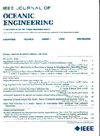基于标定姿态信息的舰载双基地HFSWR目标回波运动补偿方法
IF 5.3
2区 工程技术
Q1 ENGINEERING, CIVIL
引用次数: 0
摘要
舰载双基地高频表面波雷达(HFSWR)是一种新型的高频表面波雷达系统,其发射站和接收站部署在不同的舰载平台上。它结合了双基系统强大的隐蔽性和抗干扰能力以及舰载系统的机动性和灵活性的优点。然而,对于舰载双基地HFSWR雷达,雷达回波同时受到两个舰载平台联合运动调制的影响,导致目标回波和诱导峰的增宽。因此,有必要对目标回波进行运动补偿处理。惯性导航姿态信息可以用于运动补偿,但姿态数据的延迟会影响补偿性能。此外,直接波信号可用于估计平台姿态信息进行运动补偿,但该方法会因噪声而降低性能。提出了一种基于标定姿态信息的舰载双基地HFSWR目标回波运动补偿方法。首先,考虑到可以采用岸船双基地的运动补偿方法,将两船调制模型转化为岸船模型;然后,利用直波信号作为辅助参考源估计舰载平台的姿态信息,利用直波信号对惯导姿态数据进行标定,消除惯导姿态数据的时延误差,并利用标定后的姿态数据进行运动补偿。最后,仿真结果表明,该方法可以进一步提高运动补偿的性能。本文章由计算机程序翻译,如有差异,请以英文原文为准。
Motion Compensation Method for Target Echoes of Shipborne Bistatic HFSWR Using Calibrated Attitude Information
Shipborne bistatic high-frequency surface wave radar (HFSWR) is a new type of HFSWR system, where the transmitting and receiving stations are deployed on different shipborne platforms. It combines the advantages of strong concealment and anti-interference capability of the dual-base system, as well as the mobility and flexibility of the shipborne system. However, for shipborne bistatic HFSWR radar, radar echoes are simultaneously affected by the combined motion modulation of two shipborne platforms, resulting in the broadening of target echoes and induced peaks. So, it is necessary to perform motion compensation processing for the target echo. Inertial navigation attitude information can be used for motion compensation, but the delay of attitude data will affect the compensation performance. In addition, the direct wave signal can be used to estimate the platform attitude information for motion compensation, but the performance of this method will be reduced due to noise. This article proposes a motion compensation method for shipborne bistatic HFSWR target echoes based on calibrated attitude information. First, considering that the motion compensation method of shore-ship bistatic can be adopted, the two-ship modulation model can be transformed into the shore-ship model. Then, the direct wave signal is used as the auxiliary reference source to estimate the attitude information of the shipborne platform, the inertial navigation attitude data are calibrated with it to eliminate the delay error of inertial navigation attitude data, and the calibrated attitude data are used for motion compensation. Finally, the simulation results show that the proposed method can further improve the performance of motion compensation.
求助全文
通过发布文献求助,成功后即可免费获取论文全文。
去求助
来源期刊

IEEE Journal of Oceanic Engineering
工程技术-工程:大洋
CiteScore
9.60
自引率
12.20%
发文量
86
审稿时长
12 months
期刊介绍:
The IEEE Journal of Oceanic Engineering (ISSN 0364-9059) is the online-only quarterly publication of the IEEE Oceanic Engineering Society (IEEE OES). The scope of the Journal is the field of interest of the IEEE OES, which encompasses all aspects of science, engineering, and technology that address research, development, and operations pertaining to all bodies of water. This includes the creation of new capabilities and technologies from concept design through prototypes, testing, and operational systems to sense, explore, understand, develop, use, and responsibly manage natural resources.
 求助内容:
求助内容: 应助结果提醒方式:
应助结果提醒方式:


